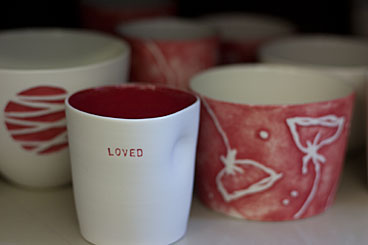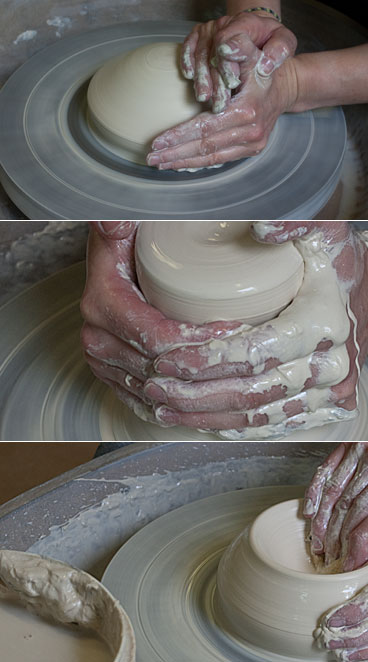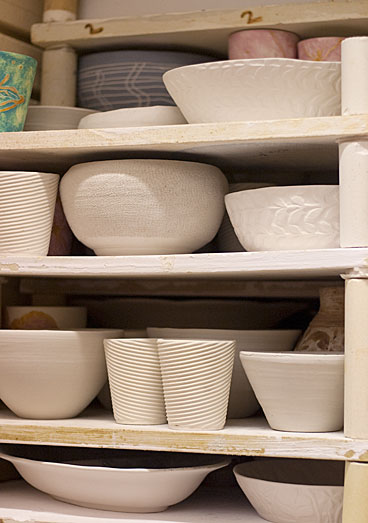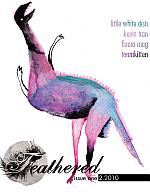little white dish
When Deb Taylor decided two years ago to pursue her ceramics career full-time, she made the right choice. We spent an afternoon with Deb in her studio recently, and her enthusiasm for each step in the ceramic process is infectious! She feels lucky to have discovered clay and to have persevered with it - and she's proud of herself for taking the leap into self-employment so she can spend every day at the wheel.

Deb was originally drawn to ceramics when the practice became popular among her friends. She did a few community college classes which taught her the basics of throwing and hand-building and were great fun, but Deb was looking for more. She wanted to express herself through the medium rather than create pieces that were part of a set course, so she enrolled at the National Art School and spent the next three years studying studio ceramics.
When asked what she enjoys most about the process, Deb replies "plunging my hands in to the bucket of creamy Limoges slip is so sensual and rewarding, and then to transform a ball of clay into a vessel. It's an amazing ability to be able to do this and I remember how it all seemed so difficult and frustrating in the beginning." She also loves playing with surface decoration, as with her customised pieces featuring text written with tiny typewriter keys. Each cup or bowl takes on it's own personality, depending on whether Deb decides to keep it sweet (eg. with her popular "LOVED" or "CHERISHED" texts) or add something suggestive!

There's something comforting about loading a kiln. Deb describes the "reasonably slow process of including as many pieces as possible to avoid wasting space and energy... a challenge to fill every space". The process probably gives her time to contemplate the work so far; to let her consolidate the ideas and new twists that differentiate this batch of pots from the last.
Chance plays a large role when the vessels begin their journey through the kiln. This period of 'adolescence' where each piece grows up outside of the artist's influence is unique to the ceramics discipline. Each vessel shrinks by up to 15%, and the intense heat can cause unexpected changes. Waiting for the kiln to cool down enough to open makes Deb feel that time has slowed down. She uses the same glazes and firing programs, but it's still an anxious and excited wait...
Experimentation usually happens by accident, and new ideas tend to change many times before a new technique or colour is committed to the kiln. Deb finds inspiration in the "things people say, things people want to say to another or a loved one via a vessel", and, perhaps not surprisingly, paper. Absence of much decoration is a feature of most of her work, and she wonders if has something to do with the experience of getting new exercise books at school and not wanting to spoil them. Sometimes she prefers not to have any colour in the stamped word at all, so it really is more like a whisper (or invisible ink). You have to get closer to these pieces to read what it says - they are quiet & intimate.
Deb is also influenced by the way light dances on porcelain, and although it's not apparent in her current work, "that graffiti-ridden industrial aesthetic". Deb has been experimenting with incorporating found pieces of rusty metal - the contrast with the bright white porcelain is stunning & this year will see further development of her ideas.

Looking at the Little White Dish range, Deb describes the red poppies vessels as a "hot burst of newness - like a new love". The poppies are done in relief, so they have an intriguing textured surface which also plays with the light as the poppies become backlit by the illuminated interior.
Since ceramics are so tactile, Deb loves to use anything with a beautifully curved bottom that sits perfectly comfortably in her hand with an accommodating dimple for her thumb. "The spoon will move speedily along the parabolic curve - no escape for the ice-cream!"
There are many challenges to learning pottery, and people often don't realise how difficult it can be; how throwing fine pieces isn't somrthing that will happen without lots of practice. This is one reason why Deb loves teaching. "When you see somebody make even the smallest of bowls or cylinders, it's a great joy to see their faces light up with a sense of achievement after ,what can be for some, a lot of frustration." There are huge differences between clays and firing temperatures, and students often don't realise how incredibly fragile pieces can be prior to firing. It certainly looks like a bowl or cup, but when picked up like one, may fall apart in their hands. "That's a steep learning curve."

Deb teaches short courses in pottery at UNSW, where she is Artist in Residence. She doesn't feel that teaching directly influences her work, but the regular, positive feedback is lovely confirmation that she's still on the right track! Some students borrow certain elements from Deb's work, such as the simplicity of smooth lines and shapes interrupted by a solitary dimple - a signature mark for Little White Dish. Many ex-students also sign up for university membership and continue with their throwing. It gives Deb a thrill to have inspired them & got them hooked on ceramics just as she once was - and still is!
From a technical point of view, it's really valuable to have other artists & potters around to discuss ceramic issues & problems. The pottery studio at UNSW is a "precious space" and every day Deb feels lucky to be there, working alongside others who share the same passions.
When asked about the future, Deb mentions the possibility of an exhibition. She has enjoyed taking part in group exhibitions, so maybe she'll prepare a body of work which is more exhibition-based. She'd also like to reduce her carbon footprint and find an Australian replacement for Limoges (the very fine white clay from France). "It'll be a very tearful goodbye..."

